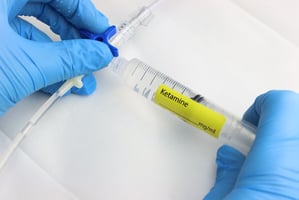Ketamine's Antidepressant Effects Appear to Depend on Opioid System, Study Shows
 |
The study, by Alan Schatzberg, M.D. (pictured left), the Kenneth T. Norris Jr. Professor of Psychiatry and Behavioral Sciences at Stanford University School of Medicine, and colleagues, found that when patients with treatment-resistant depression were treated with the opioid antagonist naltrexone before receiving an infusion of ketamine, the antidepressant effects of ketamine were dramatically diminished.
“While opioids have a history of use as antidepressants, they pose a significant risk if used chronically,” Schatzberg and colleagues wrote. “Thus, the abuse and dependence potential of frequent ketamine treatment in major depression needs further study, and our results provide strong justification for further caution against widespread and repeated use of ketamine before further mechanistic testing has been performed.”
The researchers originally planned a crossover trial of 30 adults with treatment-resistant depression comparing a 0.5 mg/kg intravenous infusion of ketamine preceded by either oral placebo or oral naltrexone (50 mg). All participants were required to have a score of at least 20 on the 17-item Hamilton Depression Rating Scale (HAM-D). Each participant was also required not to have benefited sufficiently from trials of at least four antidepressant medications or other somatic treatments (such as electroconvulsive therapy, vagus nerve stimulation, or deep brain stimulation).
An initial 12 patients completed both arms of the crossover trial. In the ketamine plus placebo condition, seven of the 12 patients met the criterion for response (defined as a reduction of 50 percent from baseline to post-infusion day 1 in 17-item HAM-D score); five of the seven responders met criteria for remission (defined as a score of 7 or less on HAM-D). In contrast, none of the patients who responded to ketamine plus placebo met the criteria for response the day after receiving ketamine plus naltrexone.
Patients receiving ketamine plus placebo experienced a dramatic reduction in mean 17-item HAM-D, with an average reduction of 22.3. There was also a statistically significant reduction from baseline in the ketamine plus naltrexone condition, but that improvement was significantly lower, with an average reduction of 5.6. Because patients who took naltrexone before ketamine continued to experience the dissociative effects of ketamine without the robust antidepressant response seen in the placebo group, the investigators halted the trial without recruiting more patients.
“With these new findings, we should be cautious about widespread and repeated use of ketamine before further mechanistic testing has been performed to determine whether ketamine is merely another opioid in a novel form,” Mark George, M.D., a professor of psychiatry, radiology, and neuroscience and director of the Brain Stimulation Laboratory at the Medical University of South Carolina, wrote in an accompanying editorial. “[W]e need to better understand ketamine’s mode of action and how it should best be used and administered.”
A detailed report of this study will appear in a future issue of Psychiatric News and its enewsletter PsychoPharm. For related information, see the Psychiatric News article “ ‘Cautious Optimism’ Marks Outlook for Ketamine, Mood Disorders.”






